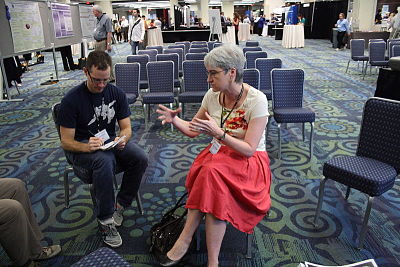 Communication
Communication Building Buzz Really Is a Good Career Move

This still works really well, too: at the 2011 Association for Psychological Science convention, a member of APS talks with a reporter.
Astronomer Carl Sagan received a lot of awards in his lifetime: a Peabody, a Pulitzer, two Emmys, a pair of Distinguished Public Service Medals from NASA, even a landing site dubbed the Carl Sagan Memorial Station on Mars. What the then host of the first iteration of TV’s Cosmos didn’t get was membership in National Academy of Sciences, reportedly because his outsize public fame rubbed many other scientists the wrong way.
The lesson wasn’t lost on his peers, the authors of a new paper on communicating science write in the journal, Journalism & Mass Communication Quarterly: “there continues to be a normative assumption among scientists that public communication is not valuable or is even detrimental to their academic careers … In fact, the term Sagan-ization is often used to describe scientists who ‘become popular enough as an explainer of science to risk the contempt of more ‘serious’ researchers.’”
But there are benefits to speaking directly to the public (and to be fair, two years after rejecting him as a member the National Academy did give Sagan its Public Welfare Medal in large part for that public outreach). In their paper, “Building Buzz: (Scientists) Communicating Science in New Media Environments,” Xuan Liang and seven co-authors take a look at the best way of using new media can amplify a researcher’s personal impact factor. Their proxy for this impact factor is the bibliometric ‘h-index,’ a measure designed by physicist Jorge Hirsch in which “index h if h of his or her Np papers have at least h citations each and the other (Np − h) papers have ≤ h citations each.” In short, lots of citations to a researcher’s works result in a high h-index, and that’s reckoned to be a good thing. So for this paper, techniques that correlate with higher h-indices are seen as working. (And be careful not to confuse the h-index with the tongue-in-cheek k-index …)
So what techniques build buzz – and careers? Blogging? Tweeting? Talking with reporters?
Want to Start Tweeting?
6 Reasons Why Researchers (of Any Age) Should Get Tweeting
How to Live Tweet at an Academic Event
Tweeting Academics Weigh In on Social Media
If you could only pick one — and that’s not a requirement — Liang and her colleagues find Twitter to be a highly effective way of boosting impact, specifically by having the researchers and their work mentioned in the tweet (as opposed, say, to just having a Twitter account). Less surprising, but still worth remembering, talking with reporters also works well in boosting impact, although that’s clearly more labor intensive than tweeting. Not only is being mentioned on Twitter a positive, but tweets seem to amplify the benefits of interacting with journalists or with the public at large.
Not everyone is on Twitter; only 16 percent of Americans use it. “Nonetheless,” the authors write, “Twitter should still be viewed as a critical platform for science information exchange and public science communication, due in part to the sheer volume of science-related posts on Twitter.”
That’s what works. What doesn’t work—what didn’t correlate with an increase in the h-index — is science blogging and having interactions with non-scientists. That was not what the researchers had expected; they’d hypothesized that just about any sort of public outreach was bound to help boost buzz to some extent.
Now this paper is loaded with caveats, which we’ll deal with momentarily. But the larger takeaway doesn’t have to be that ‘Twitter is better,’ but rather further proof that intelligent outreach to the public will help your career by increasing your own impact factor. Furthermore, those specific techniques may potentially matter more than traditional metrics of success (which is of course the message of the altmetrics movement):
Yet social media may also present the scholarly community with new challenges related to traditional metrics of success. In academic circles, book blurbs from well-known scholars or book reviews by prestigious media outlets are generally considered more impactful than those from less well-known entities. A similar logic applies to social media. If a scientist’s work is tweeted by prominent science reporters (such as Andrew Revkin, who has more than 50,000 followers on Twitter), scientists (such as Neil deGrasse Tyson with more than 1.5 million followers on Twitter), or science media outlets (such as Science Friday with over 446,000 followers on Twitter), it is likely to attract more attention and have a larger impact even within academic circles, than a study that was only published in a peer-reviewed academic outlet (even for elite outlets, such as Nature and Science with impact factors of 36.28 and 31.2, respectively). The rewards for public communication efforts on social media may eventually force academics to think more carefully about mapping academic impact in a world of sites, such as Google Scholar and ResearchGate.com, which combine social media metrics with indicators of scholarly productivity to measure the broader impact of academic work.
Keep in mind that word ‘eventually.’ There’s still monsters in the cyber terra incognita, ranging from “readers’ uncivil comments” to the unstructured, unreviewed and unsanctioned use of findings by nonspecialists with a keyboard. But the Internet isn’t going away, so as the “boundaries that separated scientists, journalists, and the public may be blurring,” avoidance is unlikely to be an option.
That’s something that Matt Shipman at SciLogs, writing about this paper, also noted:
Confirmation bias is when people find information, or interpret it, to support their own preconceived notions. And I may be as guilty of this as anyone. That said, this study strengthens arguments that it is worth a scientist’s time to publicize his or her work – particularly by working with reporters. It also supports my longstanding position that using social media is not (necessarily) a waste of time.
The authors identified a number of limitations to their findings, making their paper less a roadmap and more a travel suggestion. The h-index, for one thing, while popular and widely understood, is an imperfect vessel for definitive results. Older and tenured scientists, for example, have higher h-indices. Go figure. And the small sample size drawn from a particular field, 241 highly cited nanoscientists at elite institutions, may not be generalizable. (That works two ways: because the scientists were already somewhat known, the results weren’t muddied by flash-in-the-pan outliers.)
So as science outreach becomes more and more focused on the lay public, perhaps we won’t have to create a new eponym, Tyson-ization, for any dire impacts on the current host of Cosmos.































































































In most of the occasion we are really worried about our career growth. Without any career goal we can’t predict any kind of success in life; therefore we need better career growth with motivation and challenges. So it is quite better to be more conscious about our career through the help of proper dedication and determination. I hope most of the people are also taking the help of different career coaching service in order to deal with their low profile career growth.